- Home
- Tony Hillerman
Talking God jlajc-9 Page 3
Talking God jlajc-9 Read online
Page 3
Leaphorn waited. But Agnes Tsosie had said what she had to say.
“Did he answer your letter?”
“Not yet,” she said. “Or maybe he did and his letter is down at Beta Hochee. That’s where we pick up our mail.”
“Nobody has been by the trading post there for a while,” Jolene Yellow said. “Not since last week.”
“Do you think you know who this man’s grandmother was?” Leaphorn asked.
“Maybe,” Agnes Tsosie said. “I remember they said my mother had an aunt who went away to boarding school and never did come back.”
“Anyway,” Jolene Yellow said, “he’s not the same man.”
Leaphorn looked at her, surprised.
“He sent his picture,” she said. “I’ll get it.”
It was about two inches square, a color photograph of the sort taken by machine to be pasted in passports. It showed a long, slender face, large blue eyes, and long blond hair woven into two tight braids. It was a face that would always look boyish.
“He certainly doesn’t look like a Navajo,” Leaphorn said. He was thinking that this Henry Highhawk looked even less like the man with the pointed shoes.
Chapter Four
« ^ »
From behind him in the medicine hogan, Officer Jim Chee could hear the chanting of the First Dancers as they put on their ceremonial paint. Chee was interested. He had picked a spot from which he could see through the hogan doorway and watch the personifiers preparing themselves. They were eight middle-aged men from around the Naschitti Chapter House in New Mexico, far to the east of Agnes Tsosie’s place below Tesihim Butte. They had painted their right hands first, then their faces from the forehead downward, and then their bodies, making themselves ready to represent the Holy People of Navajo mythology, the yei, the powerful spirits. This Night Chant ceremonial was one that Chee hoped to learn himself someday. Yeibichai, his people called it, naming it for Talking God, the maternal grandfather of all the spirits. The performance was nine days long and involved five complicated sand paintings and scores of songs. Learning it would take a long, long time, as would finding a hataalii willing to take him on as a student. When the time came for that, he would have to take leave from the Navajo Tribal Police. But that was somewhere in the distant future. Now his job was watching for the Flaky Man from Washington. Henry Highhawk was the name on the federal warrant.
“Henry Highhawk,” Captain Largo had said, handing him the folder. “Usually when they decide to turn Indian and call themselves something like Whitecloud, or Squatting Bear, or Highhawk, they decide they’re going to be Cherokees. Or some dignified tribe that everybody knows about. But this jerk had to pick Navajo.”
Chee was reading the folder. “Flight across state lines to avoid prosecution,” he said. “Prosecution for what?”
“Desecration of graves,” Largo said. He laughed, shook his head, genuinely amused by the irony. “Now ain’t that just the ideal criminal occupation for a man who decides to declare himself a Navajo?”
Chee had noticed something that seemed to him even more ironic than a white grave robber declaring himself to be a Navajo—a tribe which happened to have a fierce religious aversion to corpses and everything associated with death.
“Is he a pot hunter?” Chee asked. “Is the FBI actually trying to catch a pot hunter?” Digging up graves to steal pre-Columbian pottery for the collector’s market had been both a federal crime and big business on the Colorado plateau for generations, and the FBI’s apathy about it had been both unshakable and widely known. Chee stood in front of Largo’s desk trying to imagine what would have stirred the federals from such historic and monolithic inertia.
“He wasn’t hunting pots,” Largo said. “He’s a politician. He was digging up belagaana skeletons back East.” Largo explained what Highhawk had done with the skeletons. “So not only were they white skeletons, they were Very Important People belagaana skeletons.”
“Oh,” Chee said.
“Anyway, all you need to know about it is that you go out to the Lower Greasewood Chapter House and you find out where they’re holding this Yeibichai. It will probably be at Agnes Tsosie’s place. She’s the one they’re doing the Night Chant for. Anyway, this Highhawk nut is supposed to come to it. Probably he’s already there. The FBI says he rented a Ford Bronco from Avis in Washington. A white one. They think he drove it out here. So you get yourself to Old Woman Tsosie’s place. If he’s there, bring him in. And if he’s not there yet, then stick around and wait for him.“
“Nine days?”
“Tonight’s the last night of the Yeibichai,” Largo said. “That’s when Mrs. Tsosie said she told him to come.”
“What makes us think this guy is coming all the way out here for a Yeibichai? Sounds strange to me.” Chee had been looking at the sheet in the folder when he said it. When he looked up, Captain Largo was glowering at him.
“You don’t get paid to make decisions on whether the feds know what the hell they’re doing,” the captain said. “You get paid for doing what I tell you to do. But if it makes you happier, we’re told that this Highhawk told it around back in Washington that he was coming out to the Navajo Reservation to attend this specific Agnes Tsosie Yeibichai. Is that good enough for you?”
It had been good enough. And so for the past four hours Chee had been at the Agnes Tsosie place waiting for Henry Highhawk to arrive at this Yeibichai ceremonial so that he could arrest him. Chee was good at waiting. He waited at his favorite lurking point near Baby Rocks Mesa for the endless empty miles of U.S. 160 to provoke drivers into speeding. He waited at the fringe of rodeo crowds for unwary bootleggers, and in the hallways outside the various Navajo Nation Department of Justice courtrooms to be called in to testify. Deputy Sheriff Cowboy Dashee, his good friend who had tagged along on this venture, complained endlessly about the waiting their jobs required. Chee didn’t mind. He had one of those minds in which curiosity is constantly renewed. Wherever he waited, Chee’s eyes wandered. They always found something that interested him. Here, waiting for the white Ford Bronco to appear (or fail to appear), Chee was first fascinated with the ceremonial itself. And then he’d noticed the Man with Bad Hands.
Bad Hands was curious indeed.
He had arrived early, as had Chee, a little before sundown in that recess between the afternoon singing in the medicine hogan and the dancing of the yeis, which would begin only when the night was totally dark. He was driving a green four-door Jeep Cherokee which bore a Farmington car rental company’s sticker. Chee had identified him at first as a belagaana, that grab bag of social-ethnic types which included whites plus all those who were neither fellow members of the Dineh (Navajos), nor Nakai (Mexicans), nor Zunis, nor Hopis, nor Apaches, nor Utes, nor members of any of the other Indian tribes who lived near enough to the Navajos to have earned a name in the Navajo language—which had no noun for “Indian.” Thus Bad Hands was belagaana by default. Bad Hands wasn’t the only white attracted by this ceremonial, but he was the only one who defied Chee’s personal classification system.
The handful of other whites standing around the bonfires or keeping warm in their vehicles fit neatly enough. Two were “friends.” They included a lanky, bald-headed man from whom Chee sometimes bought hay at a Gallup feed store, and Ernie Bulow, a towering, gray-bearded desert rat who’d been raised on the Big Reservation and had written a book about Navajo taboos. Bulow spoke coherent Navajo and had developed close personal relationships with Navajo families. He had brought with him today in his dusty station wagon a fat Navajo man and three middle-aged white women, all of whom stood beside the vehicle looking cold, nervous, and uncomfortable. Chee put the women in his “tourist” category. The remainder of the belagaana delegation were mostly “Lone Rangers”—part of the liberal/intellectual covey. They had flocked into the Navajo Mountain territory and declared themselves spokesmen for, and guardians of, the Navajo families facing eviction from their lands in what had become the Hopi part of the old Joint Use
Reservation. Lone Rangers were a nuisance, but also a source of anecdotes and amusement. There were three of these, two males not much older than Chee and a pretty young blonde woman with her hair rolled atop her head. All wore the ragged jeans, jean jacket, and horse-blanket uniform of their clique.
Bad Hands’ necktie, his neatly fitted business suit, his white shirt, his gloves of thin black leather, his snap-brim felt hat, his fur-collared overcoat, all disqualified him as a Lone Ranger. Like them he was a city person, but without the disguise. Total disinterest in the ceremonial ruled him out as a tourist, and he seemed to know no one here—most of them Bitter Water People of the patient’s maternal clan. Like Jim Chee, Bad Hands was simply waiting. But for Bad Hands, waiting was a joyless matter of enduring. He showed no sign of pleasure in it.
Chee had first noticed him when he emerged from the Jeep Cherokee. He’d parked it amid a cluster of shabbier vehicles a polite distance from the dance grounds. He had stretched, rotated his shoulders in his overcoat, bent his knees, bowed his back, went through those other movements of people who have been confined too long in a car. He gave no more than a glance to the men who were unloading sawmill waste from the tribe’s lumbermill to help fuel the fires which would warm the spectators and illuminate the dancing tonight. He was more interested in the parked vehicles. These he inspected carefully, one after another. He had noticed Chee noticing him, and he had noticed Chee’s police uniform, but he showed no special interest. After stretching his muscles he climbed back into his vehicle and sat. It was then that Chee noticed his hands.
He had opened the door by grasping the handle with two fingers of his left hand, then pressing in the release button with a finger of his right hand. It was obviously a practiced motion. Still it was clumsy. And as he did it, Chee noticed that the thumb and little finger of the right glove jutted out stiffly. The man was either missing that thumb and finger, or they were immobilized. Why then didn’t he open the door with the other hand? Chee couldn’t get a look at it.
But now Chee’s curiosity was clicked up a notch. He prowled the dance ground the Tsosie family had cleared, he chatted with people, he watched the fire builders build the stacks of logs and waste wood which would line the dancing area with flames. He talked to the husband of the woman whose mother was the patient. Yellow was his name. Yellow was worrying about everything going right.
Chee helped Yellow check the wiring from the little generator he’d rented to provide the electric lighting he’d rigged up behind the medicine hogan. Chee kept an eye on five boys wearing Many Farms football jackets who might become trouble if their group became large enough to reach teenage critical mass. Chee prowled among the parked vehicles on the lookout for drunks or drinking. He stopped where Cowboy Dashee was parked in his Apache County Sheriffs Department patrol car to see if Cowboy was still asleep. (“Wake me when your criminal gets here, or wake me when the dancing gets going,” Dashee said. “Otherwise, I need my rest.”) But always he wandered back to where he could see the Jeep Cherokee and its driver.
The man was sometimes sitting in it, sometimes leaning against it, sometimes standing beside it.
He’s nervous, Chee decided, but he’s not the sort who allows himself to show his nerves in the usual ways. When the light of an arriving car lit his face, Chee noticed that he might be part Indian. Or perhaps Asiatic. Certainly not Navajo, or Apache, or a Pueblo man. In the same light he saw his hands again, gloved, both of them, this time resting lightly on the steering wheel. The thumbs and little fingers of both hands jutted out stiffly as if their joints were frozen.
Chee was standing beside the medicine hogan thinking of these odd hands and what might have happened to them when Henry Highhawk arrived. Chee noticed the vehicle coming over the rim of the mesa and jolting toward the parking area. In the reflected light from the fires it seemed to be small and white. As it parked he saw it was the white Ford Bronco he had been waiting for.
“… Wind Boy, the holy one, paints his form,” the voices behind him chanted in rhythmic Navajo.
“With the dark cloud, he paints his form.
With the misty rain, he paints his form…“
The vehicle disappeared from sight in an irregular row of mostly pickup trucks. Chee strolled toward it, remaining out of the firelight when he could. It was a Bronco, new under its heavy coating of dust. Its only occupant seemed to be the driver. He opened the door, lighting the overhead bulb. He swung his legs out, stretched, emerged stiffly, and closed the door behind him. In no hurry, apparently.
Neither was Jim Chee. He leaned against the side of an old sedan and waited.
The cold breeze moved through the sage around him, whispering just loud enough to obscure the ceremonial chanting. The fires that lined the sides of the dance ground between the hogan and the little brush-covered medicine lodge were burning high now. The light reflected from the face of Henry Highhawk. Or, to be more accurate, Chee thought, the man I presume to be Henry Highhawk. The man, at least, who drove the prescribed white Bronco. He wore a shirt of dark blue velvet with silver buttons—the shirt a traditional Navajo would have proudly worn about 1920. He wore an old-fashioned black felt hat with a high crown and a band of silver conchas—a “reservation hat” as old-fashioned as the shirt. A belt of heavy silver conchas hung around his waist, and below it he wore jeans and boots—the left boot, Chee now noticed, reinforced with a metal brace and thickened sole. He stood for a long time beside the car in his shirt sleeves, oblivious of the cold, engrossed in what he was seeing. In contrast to Bad Hands, this visitor was obviously fascinated by this ceremonial event. Finally, he reached inside, pulled out a leather jacket, and put it on. The jacket had leather fringes. Of course it would have fringes, Chee thought. Hollywood’s Indian.
Chee strolled past him to Cowboy’s patrol car and rapped on the window.
Cowboy sat up, looked at him. Chee opened the door and slid in.
“They ready to dance?” Cowboy asked, the question muffled by a yawn.
“Any minute now,” Chee said. “And our bandido has arrived.”
Cowboy felt around for his gun belt, found it, straightened to put it on. “Okay,” he said. “Away we go.”
Deputy Sheriff Cowboy Dashee climbed out of his patrol car and followed Navajo Tribal Policeman Jim Chee toward the crowd gathering around the fires. Dashee was a citizen of Mishhongnovi on the Hopi Second Mesa, born into the distinguished Side Corn Clan, and a valuable man in the ancient Hopi Antelope Society. But he was also a friend of Jim Chee from way back in their high school days.
“There he is,” Chee said. “The cat with the reservation hat, leather jacket with the Buffalo Bill fringes.”
“And the braids,” Dashee said. “He trying to set a new style for you guys? Replace buns with braids?”
The driver of the Bronco was standing very close to a squat, elderly man in a red plaid coat, leaning over him as he first talked, then listened attentively. Chee and Dashee edged through the crowd toward him.
“Not now,” Plaid Coat was saying. “Old Lady Tsosie she’s sick. She’s the patient. Nobody can talk to her until this sing is over.”
Why would this belagaana grave robber want to see Agnes Tsosie? Chee had no idea. That irritated him. The big shots never told working cops a damned thing. Captain Largo certainly didn’t. Nobody did. Someday he would walk into something and get his head shot off because nobody had told him anything. There was absolutely no excuse for it.
Bad Hands walked past him, approached Highhawk, waited for the polite moment, touched the man’s shoulder. Highhawk looked startled. Bad Hands seemed to be introducing himself. Highhawk offered a hand, noticed Bad Hands’ glove, listened to what might have been an explanation, shook the glove gingerly. “Let’s get him,” Dashee said. “Come on.”
“What’s the hurry?” Chee said. “This guy’s not going anyplace.”
“We arrest him, we put him in the patrol car, and we don’t have to worry about him,” Dasheé said.
“We arrest him, and we have to baby-sit him,” Chee said. “We have to haul him down to Holbrook and book him into jail. We miss the Yeibichai dance.”
Dashee yawned a huge yawn, scrubbed his face with both palms, yawned again. “To tell the truth,” he said, “I forget how you talked me into coming out here anyway. It’s us Hopi that have the big tourist-attraction ceremonials. Not you guys. What am I doing here, anyway?”
“I think I told you something about all the Miss Navajo and the Miss Indian Princess contestants always coming to these Yeibichais,” Chee said. “They haul them in from Albuquerque and Phoenix and Flagstaff on buses.”
“Yeah,” Dashee said. “You did say something about girls. Where the hell are they?”
“Be here any minute,” Chee said.
Dashee yawned again. “And speaking of women, how you doing with your girlfriend?”
“Girlfriend?”
“That good-looking lawyer.” Dashee created curves in the air with his hands. “Janet Pete.”
“She’s not my girlfriend,” Chee said.
Dashee put on his skeptical expression.
“I’m her confidant,” Chee said. “The shoulder upon which she weeps. She’s got a boyfriend. In Washington. Her old law professor down at the University of Arizona decided to quit teaching and be a millionaire. Now she’s back there working for him.”
Dashee’s disappointment showed. “I liked her,” he said. “For a Navajo, that is. And for a lawyer, too. Imagine liking a lawyer. But I thought you two had something going.“
“No,” Chee said. “She tells me her troubles. I tell her mine. Then we give one another bad advice. It’s one of those things.”

 People of Darkness
People of Darkness Talking God jlajc-9
Talking God jlajc-9 Skinwalkers jlajc-7
Skinwalkers jlajc-7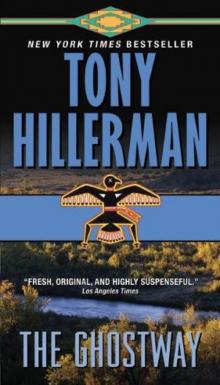 The Ghostway jlajc-6
The Ghostway jlajc-6 The Dark Wind jlajc-5
The Dark Wind jlajc-5 The Blessing Way
The Blessing Way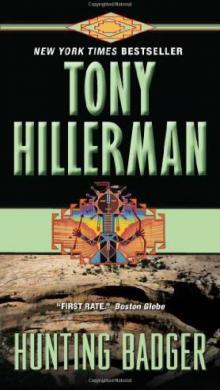 Hunting Badger jlajc-14
Hunting Badger jlajc-14 Seldom Disappointed: A Memoir
Seldom Disappointed: A Memoir Coyote Waits jlajc-10
Coyote Waits jlajc-10 Skeleton Man jlajc-17
Skeleton Man jlajc-17 The Shape Shifter
The Shape Shifter Sacred Clowns jlajc-11
Sacred Clowns jlajc-11 The Fallen Man jlajc-12
The Fallen Man jlajc-12 The First Eagle jlajc-13
The First Eagle jlajc-13 Listening Woman jlajc-3
Listening Woman jlajc-3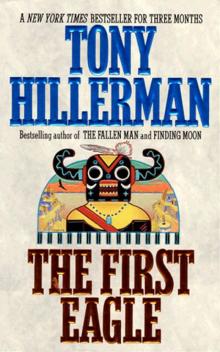 The First Eagle
The First Eagle Skeleton Man
Skeleton Man The Sinister Pig jlajc-16
The Sinister Pig jlajc-16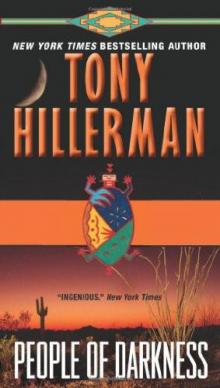 People of Darkness jlajc-4
People of Darkness jlajc-4 The Blessing Way jlajc-1
The Blessing Way jlajc-1 A Thief of Time
A Thief of Time The Wailing Wind
The Wailing Wind A Thief of Time jlajc-8
A Thief of Time jlajc-8 The Wailing Wind jlajc-15
The Wailing Wind jlajc-15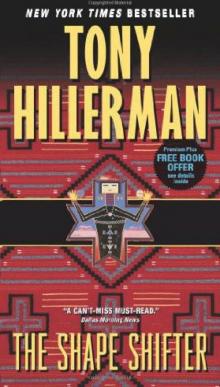 The Shape Shifter jlajc-18
The Shape Shifter jlajc-18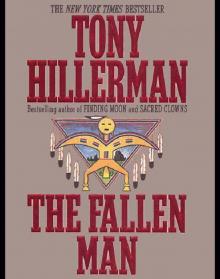 The Fallen Man
The Fallen Man Finding Moon
Finding Moon